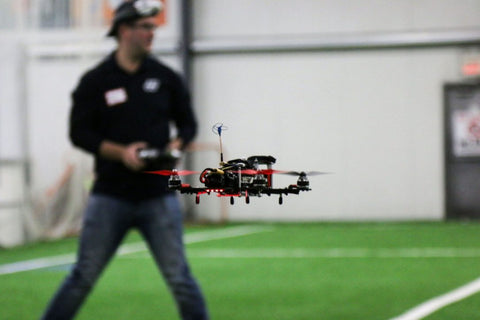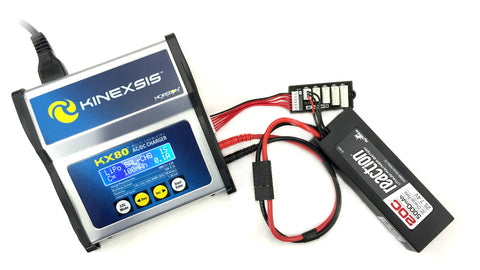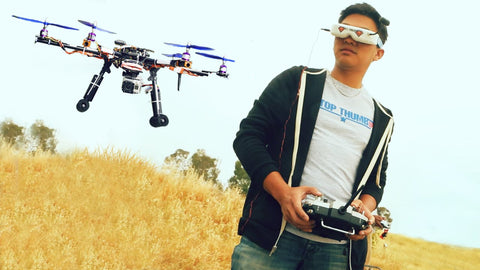Drone Ranger: What Do I Need To Start A High School Drone Racing Team? The 7 Essentials

No longer are drones just for flying in your backyard or up and down your street. Since 2012, the recreational drone arena has grown from a slow boil to a boiling cauldron.
In the last year, a lot of schools have started drone clubs and drone racing teams. Purdue University conducted a Collegiate Drone Race last spring, and since then, the sport has continued to grow.

FLYING IN FIRST PERSON
If you're new to racing, here's the gist: pilots race their drones around a course using First Person View (FPV) goggles. Each racing drone is equipped with a small video camera and transmitters, so pilots can watch in first-person as their drone speeds around the track. These young men and women pilot their drones at speeds that can exceed 75 MPH solely by watching the live video from the drone via FPV goggles.
Sound like fun? It's easy to bring this new sport to your own school by starting a drone racing team. Here's what you'll need:
1. RACING DRONES
First step: get racing drones! A school will need between 4 and 8 of them depending on the size of the school team. These drones are different from most drones you see in classrooms or electronics stores—they're small, but that doesn’t mean slower or easier to fly. In fact, they require a decent amount of practice to fly, because they don’t use GPS.
You can buy racing drones as kits or completely assembled, but we suggest getting a kit (especially one that comes with cameras and video transmitters). As students learn to pilot their drone, they'll undoubtedly crash a few times—which means it's helpful to already know how the drone is built and how it should be re-assembled when damaged.
Cost: $ 100 - $250 each.

2. REMOTE CONTROL
A six-channel remote control with a corresponding receiver is necessary to fly the drones, so your team will need one for each racer. These do require some set-up.
Cost: $60 - $140 each

3. BATTERIES AND CHARGERS
Drone races usually last about 4 to 6 minutes, but to get your racing drone up to speed, you need high-powered “juice cans"—lithium polymer batteries. Most racers use between 4S – 1600mAh 70C and a 3S 1100mAh 45C battery. To save time, get a charger that can charge one, two or four batteries simultaneously.
Pro tip: stay away from the small, inexpensive chargers—those can take hours to charge a battery and in the heat of racing, you'll either need a lot of batteries or a better charger. A good charger can charge a battery in about 20 minutes.
Cost:

4. FIRST PERSON VIEW GOGGLES
FPV Goggles have built-in video receivers that display the drone’s live video, so you can navigate the drone racing course from the perspective of your racing drone. Some goggles even have built-in DVR to record the video! This is a great way for students to share their ups and downs, since there will be lots of them.
Certain FPV goggles are sleek with a small screen in front of each eye, but these are more expensive and don't work well for students with glasses. We recommend getting FPV goggles that are larger, use a single screen and offer an adjustable diopter focus. These are less expensive and any student can use them easily.
Cost: $60-$250
5. RACING GATES
Once students get the hang of flying, you will need to set up a race course. Racing gates usually have a 5ftcenter. Racers must follow a path of marker disks, maneuver through the gates, around 6’ -12’ slalom flags. Teams can build racing gates and flags with PVC pipe and canvas to start.
Before you start, you may also want to use small marker flags to establish the dimensions of the racing area. There are several amateur and professional drone racing groups who have examples of course layouts. We recommend setting up in an area about the size of a soccer field, about 300ft long and 100ft wide.
Cost:
Gates (set of five): $100 - $400
6’ slalom flags: $40 - $85
100 field markers: $20
Boundary flags: $10

6. TIMING SYSTEM
The last item you may want is a drone race timing system. These typically require a laptop to run them and include both hardware & software. There are a couple of different types, ones that use IR LED lights on each drone and newer ones that use the video transmitter on each drone to collect timing data.
Cost: $500 - $1000
7. TOOLS
If your school has a makerspace, you will have all of the tools you will need to build and repair your drones. If not, a few pairs of pliers, soldering irons, screwdrivers, Allen wrenches, electrical tape and wire cutters are all you need for fixing up your drone after a crash.
Cost: $50-$75
Adding new equipment and standing up a team of racers is not difficult, but it does require some dedication on the part of the teacher and students. You'll also need funds—a budget of at least $1,500 is necessary to field a team of four racers.

FLYING INTO STEM EDUCATION
High school drone racing is a great way to engage all students in an exciting new sport. As they build and race drones, students may not even realize they are learning about physics, electronics, aerodynamics and a whole host of other STEM-related topics.
Schools that see the benefit in this are setting up racing chapters with MultiGP and are starting to race other school teams. With the tools above and little dedication, you can join in this new STEM sport and start racing drones around your school in no time.
Drone Racing: It's STEM education—at 75 MPH.
- Tags: Drone Drone Ranger OnPoynt STEM
- Ron Poynter


Comments 0